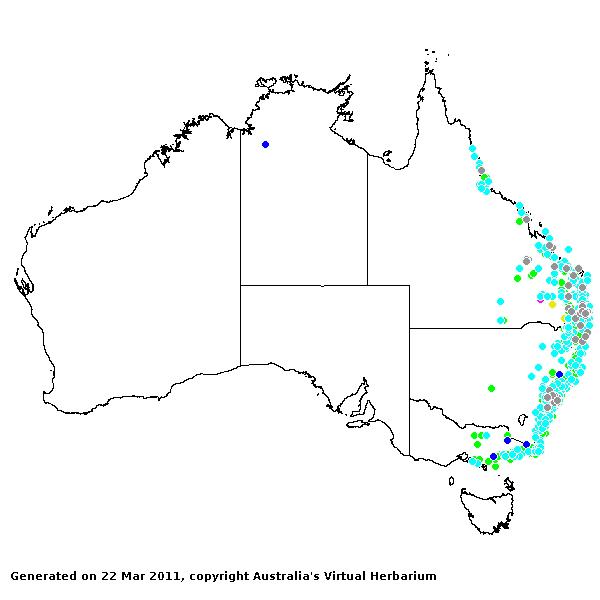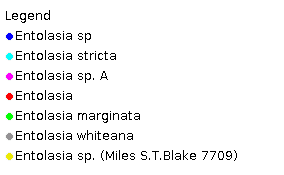Entolasia Fl. Trop. Afr. 9: 739 (1920).
Derivation:. From Greek entos (within) and lasios (hairy), referring to the hairy fertile lemma covered by the upper glume.
Key references (keys and floras):. J.W.Vickery, Flora of New South Wales, Gramineae 19: 69–72(1961); E.E.Henty, Manual Grasses New Guinea 89(1969); M.Lazarides, Tropical Grasses S.E. Asia 120–121 (1980); J.C.Tothill and J.B.Hacker, Grasses of Southern Queensland 226–227 (1983); R.D.Webster, Australian Paniceae 86–89 (1987); B.K.Simon, Key to Australian Grasses 111 (1993); S.W.L.Jacobs and C.A.Wall, Flora of New South Wales 4: 450–451 (1993); N.G.Walsh, Flora Victoria 2: 590–591 (1994); E.Edgar and H.E.Connor, Flora of New Zealand 5: 551–552 (2000); D.Sharp and B.K.Simon, AusGrass (2002); S.W.L.Jacobs, R.D.B.Whalley & D.J.B.Wheeler, Grasses of New South Wales, 4th ed, 243–245 (2008).
W.D.Clayton & S.A.Renvoize, Genera Graminum (1986), genus (469).
Native. 5 species, from tropical Africa, eastern Australia. 4 species in Australia, Qld, NSW, and Vic. Also New Guinea and New Zealand.
Habit. Perennial, rhizomatous or tufted. Culms woody and persistent (wiry, bushy), or herbaceous. Leaf blades broad or narrow, cordate or not cordate. Ligule a fringe of hairs.
Inflorescence. Inflorescence of spicate main branches or paniculate (but usually with sessile spiciform racemes, appressed to the common axis), a racemose panicle with spikelets all similar, open or contracted.
Spikelets. Spikelets 2 flowered, with 1 fertile floret, solitary or paired. Fertile spikelets with lower incomplete floret(s), elliptic or lanceolate or oblanceolate, adaxial (with lower glume against rachis), usually dorsally compressed, falling with glumes.
Glumes. Glumes unequal, (the longer) long relative to adjacent lemmas, awnless, non-keeled, dissimilar (the lower tiny, hyaline, the upper membranous and equalling the spikelet). Lower glume 0–3 nerved. Upper glume 3–7 nerved.
Florets. Lower incomplete floret(s) sterile. Lemmas awnless, 5 nerved, more or less equalling fertile lemmas to exceeding fertile lemmas, less firm than fertile lemmas to similar in texture to fertile lemmas (but shorter than the upper glume, which it resembles much more than does the upper lemma), not becoming indurated. Fertile florets 1. Lemmas similar in texture to glumes to decidedly firmer than glumes (membranous to leathery), smooth to striate, not becoming indurated, white in fruit or yellow in fruit, entire at apex, blunt, muticous, with a clear germination flap, 3–5 nerved, densely silky hairy, having margins tucked into palea. Palea relatively long, entire, 2 nerved, hairy (between the keels). Lodicules 2. Stamens 3. Grain small, compressed dorsiventrally. Hilum short. Embryo large.
Kranz Anatomy. C3.
2n = 18, 2 ploid.
Habitat. Helophytic, mesophytic, and xerophytic. Marshy places, damp grassland and dry forest. Shade species and species of open habitats.
Classification. Panicoideae; Paniceae.
Notes. Entolasia was described to account for two tropical African species with a hairy upper floret. The three Australian species are very similar to the African ones in the general form of the inflorescence and spikelet characters. However, the African species are semi-aquatic in habit whereas the Australian species occur in rocky outcrops in woodlands (Webster, 1987).
Types Species. E. olivacea Stapf.
Biogeographic Element. Clifford & Simon 1981, Simon & Jacobs 1990: Old World Tropics.


